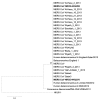MERS coronaviruses in dromedary camels, Egypt
- PMID: 24856660
- PMCID: PMC4036765
- DOI: 10.3201/eid2006.140299
MERS coronaviruses in dromedary camels, Egypt
Abstract
We identified the near-full-genome sequence (29,908 nt, >99%) of Middle East respiratory syndrome coronavirus (MERS-CoV) from a nasal swab specimen from a dromedary camel in Egypt. We found that viruses genetically very similar to human MERS-CoV are infecting dromedaries beyond the Arabian Peninsula, where human MERS-CoV infections have not yet been detected.
Keywords: Egypt; MERS; MERS-CoV; Middle East respiratory syndrome; camel; coronaviruses; dromedary; genomics; phylogeny; pneumonia; viruses; zoonosis.
Figures


References
-
- World Health Organization. Middle East respiratory syndrome coronavirus (MERS-CoV) summary and literature update—as of 20 January 2014. [cited 2014 Feb 20]. http://www.who.int/csr/disease/coronavirus_infections/MERS_CoV_Update_20...
Publication types
MeSH terms
Substances
Grants and funding
LinkOut - more resources
Full Text Sources
Other Literature Sources
Research Materials

